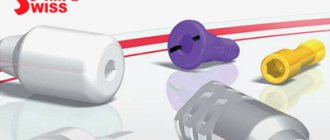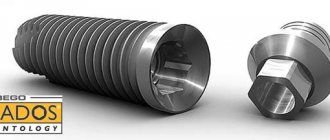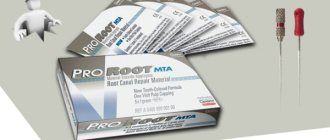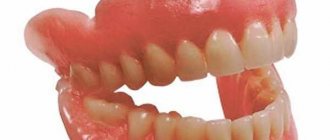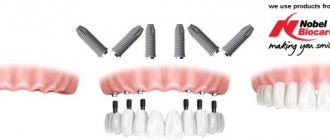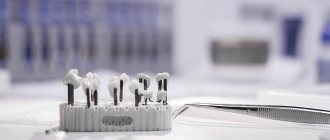Characteristics of the implant that affect the speed and quality of its survival
How long does it take for a dental implant to take root? You should always remember that the timing of osseointegration (this is the process of engraftment or fusion of the jaw bone with the implant) depends not only on the dentist and the responsibility of the person himself, but also on the quality characteristics of the selected models. Let's look at them in detail.
Model shape
World practice has shown that the most successfully implanted models are those that have a root-like and cylindrical shape, similar to the anatomy of natural tooth roots. But outdated disc or plate implants cause many difficulties for patients due to the complex procedure for fixing them in the jawbone, which is associated with a high level of trauma.
Model length
Here it must be emphasized that it is important to determine this parameter at the treatment planning stage and, based on it, select the optimal option for the clinical case:
- classic: standard length – up to 20 millimeters. Such implants use the cancellous (central section) of the bone, so before installing them, the doctor assesses the condition of the jaw bone tissue and, if necessary, builds it up,
- short models: their length does not exceed 8 millimeters. In some cases, they can complement complex solutions (for example, if you need to restore many teeth). But if there is insufficient bone, it is not recommended to use only one such implant for a single crown - it will not withstand the load,
- mini-implants: they can be either classic length or short. But their main feature is their diameter (it is very small, up to 3 mm). Such models are suitable for fixing exclusively removable dentures. Not so much for fixation, but for their support,
- elongated models: these include zygomatic types of dental implants, which can reach 60 millimeters in length. Their use is relevant for atrophic and inflammatory processes in the bone tissue of the jaw. In most cases, these designs allow one to avoid bone augmentation operations and are also used in the most complex clinical cases. But not only zygomatic implants can be long implants. For example, some basal ones are also longer than usual - and they are used not only on the upper, but also on the lower jaw, including fixation in the area of the chin bone.
Dental implantation using the Osstem system = 70,000 rubles.
All inclusive, treatment guaranteed!
Premium implants at an affordable price. Free consultation with an implantologist +7 (495) 215-52-31 or write to us
Material used
The highest survival rates among dental implants are those containing pure titanium, because it is completely biocompatible with our body. Typically, this pure material is used by premium brands, the price of which is very high. For example, all Nobel Biocare models are created from a Grade 4 brand.
Improved options also have good osseointegration rates: for example, titanium with zirconium dioxide, which Straumann uses in its Roxolid line. Thanks to this tandem, implantation systems are strong, but thinner, which provides wide treatment options for people with a narrow alveolar ridge. Interestingly, the company also produces models made of zirconium dioxide - the Pure line. They are recommended only for the anterior, aesthetically significant area.
But does this mean that companies that produce implants made of titanium with impurities (for example, vanadium) are supplying the dental market with a bad product? No, it’s just that the overall rates of osseointegration and survival time for such systems are somewhat lower, but again, we repeat that if you choose a good doctor and strictly follow his recommendations, you will also get a good final result.
Good to know! Why is it generally bad to have vanadium and aluminum in implants? They were previously thought to be toxic. But not so much that they cannot be installed. In fact, the problem is different: they “slow down” osseointegration a little, that is, they take root more slowly. Therefore, if they are created from Grade 5 material, there can be no talk of any immediate loading with a prosthesis (unless there are other factors, of course).
Another biocompatible material is tantalum. This is also a metal, its characteristics are similar to titanium. However, it is much heavier than it, and more expensive, because... occurs less frequently. Tantalum is used by only 1 brand in the world - Zimmer.
Coating characteristics (implant surfaces)
Today, almost all implant systems have a rough surface. It is needed so that bone tissue cells literally “grow” into the body of the implant. But “roughness” is achieved in different ways:
- RBM coating: this is the very first type to be used, and today it is not used by almost all manufacturers. This coating can only be achieved by sandblasting. What does it mean? After manufacturing, an air flow with microparticles (usually titanium dioxide) is directed onto the implant.
- SLA coating: replaced the previous type. Here, in addition to sandblasting, acid etching is also used. This allows you to achieve high sterility and create micropores on the coating,
- SLA-active: but this is the latest generation coating. It is based on classic SLA, but additionally also applies the application of any active compounds (phosphorus, calcium, fluorine), which accelerate the restoration and growth of bone tissue cells.
Not all brands use these exact names to designate the types of coatings on their products. In addition, some have their own special, patented ones. For example, Nobel offers TiUnite® coating with a high phosphorus content, which promotes accelerated production of bone cells and their rapid regeneration. In addition, the same company introduced another coating in 2021 - Xeal. For integration not only with bone, but also with gingival tissue (era of mucointegration).
Straumann has additionally developed a hydrophilic surface, which ensures rapid cell growth into micropores. Such features make it possible to reduce the time of osseointegration into the bones, even with classic two-stage implantation options, to 2-3 months.
Astra Tech has an OsseoSpeed® coating, enriched with fluoride ions, again for faster restoration of bone tissue cells.
But not all implants have a porous coating. For example, Oneway Biomed brand basal and cortical models have a smooth surface and an antimicrobial outer layer. It would seem that they should not take root then? But their peculiarity is their installation in deeper and denser sections of the bone, as well as a special type of thread. In addition, due to the fact that they are smooth, they can be placed in contact with the gum - this is especially important in patients with periodontitis. That is, the infection will not “cling” to the pores of the implant, thereby reducing the risk of developing peri-implantitis.
Thread types
The thread can be active, aggressive, or combined. An individual solution must be selected in each specific case. Thus, active threading promotes bone compression, i.e. when the implant itself is screwed in, it is compacted, thereby ensuring high initial and subsequent stability. The structure holds well inside the bone, and the possibility of it falling out if the installation technique[1] is followed by the dentist and adequate operation is practically excluded.
Aggressive carving is good in cases where the implant needs to be fixed in the deep layers of the bone. And combined models are equipped with different types of threads throughout the entire body. For example, in the area of the central bone there is a wide thread pitch, and in the cortical area it is narrower. Or vice versa - each manufacturer is different. The main thing here is that good fixation is achieved, both immediately after installation and in the long term.
Connection to abutment
There are one-piece models (the implant and abutment are a single integral structure) and two-piece ones. It is believed that the use of one-piece models reduces the risk of complications and increases the survival rate of implants due to the absence of joints in which pathogenic bacteria can accumulate. But again, this is relevant mainly for situations of acute atrophy and acute tissue inflammation.
But this does not mean that two-piece models are bad. The main thing is that they are made with high quality, and when connecting the abutment and the artificial root, there are no gaps or cracks left. It is also important that all elements of the system are original, and that the implants and abutments are purchased from the same manufacturer. That is, it is impossible to install a Nobel implant, and an abutment from the Astra Tech system - they are simply incompatible, because have not undergone any testing and do not fit to the nearest millimeter. The same applies to universal analogues - no one tests them at the factory or checks the quality of the connection, so problems may arise in the long term.
Types of abutments for implants
It is also worth noting that there are different types of abutments. For example, they can be standard and custom, temporary and spherical, can have different types of connections to the implant (for example, hex or three-channel connection, external or external fastening), can be created from titanium or from zirconium dioxide. To eliminate the risks of further complications, for each patient it is important for the doctor to select exactly the abutment that will be the right solution for a specific clinical case and will be ideally positioned in the “implant-abutment-prosthesis” connection.
For example, although individual models are developed taking into account anatomical features, they fit less tightly to the implants themselves. In addition, they are created in a dental laboratory (and not at a manufacturing plant), in which specialists simply do not have the technical capabilities to assess the load that they can withstand. Therefore, their use will be advisable in the case of restoration of the front teeth, where the aesthetics of the smile is important, but for the restoration of chewing units they should be used with great caution. But it’s better to choose the option offered by the implant manufacturer; after all, in this case, the product has undergone numerous tests.
Also today it is more advisable to use abutments with a type of connection such as an internal hexagon. This type of fastening, in contrast to the external hexagon, is complemented by a conical part - it is placed inside the implant, thereby ensuring reliable fastening of all elements of the system, minimizing the risk of unwinding and the formation of gaps, accumulation of bacterial plaque between the elements.
Clinical assessment
The doctor must conduct a comprehensive examination to determine possible risks and prevent complications. Comprehensive analysis and treatment planning are of great importance for the implementation of the implantation procedure and the predictability of success.
One of the most important factors taken into account is the biological connection between the implant and the bone. If you implant a prosthesis into healthy tissue, it will hold up better.
Poor bone tissue requires additional healing after bone grafting. It helps to maximize the contact of the prosthesis with the bone before occlusal load. The anatomical location of adjacent teeth is also important. The interdental spaces are carefully measured. For example, to place a 4 mm implant, a distance of 7 mm will be required. For 6 mm - approximately 9 mm. Some differences may be due to the type of components used. However, there should be enough space left for the formation of healthy tissues and hygiene procedures.
Memo to the patient after implantation
In combination with clinical assessment, the patient's current health status and prognosis of how well the wounds will heal after treatment are important. Risk factors that need to be discussed include:
- Diabetes;
- Bone metabolic disorders;
- Osteoporosis;
- State of immunodeficiency.
Behavioral conditions that may prevent the implant from being implanted include tobacco use and substance abuse. The presence of infections, especially those associated with oral pathologies, must be taken into account.
Useful recommendations for patients on how to get guaranteed results
In this section, we have listed the factors that affect the quality of implant healing. Not all of them can be influenced by the patient himself. However, you need to study all the documents, ask the clinic administrator and the doctor directly all questions regarding your treatment. Even if it’s a little, it will still help you protect yourself from low-quality and unprofessional dental implantation.
The quality of the implant itself
An implant made from low-quality material and not undergone a sufficient number of clinical studies may simply not take root. Therefore, it is worth choosing products from trusted manufacturers who value their reputation and constantly test and improve their products (this can be confirmed by the long-term existence of the manufacturing company in the implantology industry, published studies on official websites). The manufacturer always provides a quality certificate, as well as a serial number registered in the common system.
Elimination of contraindications
Before dental implantation, it is important to exclude absolute contraindications for surgical intervention - the presence of malignant tumors, uncontrolled diabetes, impaired blood hemostasis, mental disorders, tuberculosis, pathologies of the cardiovascular system and the risk of developing a heart attack or cardiac arrest, problems with the immune system and the thyroid gland.
You should never agree to implantation if you are offered to do it on the very first day. You may feel healthy, but you may have a low-grade inflammatory process or an elementary viral infection that has weakened your immune system and, during the rehabilitation period, will prevent the implants from taking root well. Before implantation, it is necessary to at least undergo a computed tomography scan, blood tests, and in some cases, obtain advice from highly specialized specialists, for example, an endocrinologist, cardiologist, or otolaryngologist (ENT).
There is also a list of relative contraindications, where it will not be possible to do without thorough preparation for implantation or shifting the timing of implant installation. For example, implants can only be installed when the patient reaches 18 years of age. Women should not undergo the procedure during menstruation, pregnancy or breastfeeding. Women during menopause should also carry out the procedure with caution, because... during this period of time, metabolic processes in the body are disrupted, associated problems arise, for example, bone fragility, deterioration of metabolic processes - before implantation in this case, it is recommended to undergo an extended list of tests to identify contraindications.
There is an obvious risk that implants will not take root well even when the patient has diseased or damaged teeth. They must be treated or removed before implantation. Otherwise, they will become a breeding ground for infection and lead to the development of peri-implantitis.
Doctors also identify a so-called risk group, which includes people who have health problems or other problems (for example, smoking or a tendency to alcoholism): the presence of periodontitis or periodontal disease, ENT diseases, controlled diabetes, hepatitis, viral diseases , osteoporosis, bruxism - in patients with similar problems, as well as in older people, it is imperative to exclude even the slightest contraindications. Dental implantation cannot be performed during periods of exacerbation of any pathologies; health monitoring is also required during the rehabilitation period. Before the procedure, you need to undergo an extensive examination and visit “specialized” specialists. For patients diagnosed with diabetes mellitus and with impaired cardiac function, it is important that treatment and subsequent recovery take place under the supervision of an endocrinologist and cardiologist, respectively.
The patient's compliance with all doctor's recommendations
An experienced dentist and a well-performed implant procedure ensure a 90% success rate. Then responsibility passes directly to the patient. Therefore, both before and after the operation, it is very important to maintain oral hygiene to prevent infection of the wound with the installed implant. In addition, it is very important to take medications prescribed by a doctor and lead a calm lifestyle, excluding from it, especially at first, alcohol, smoking, physical activity, overheating, flying, visiting steam rooms and saunas. It is also important to limit the load on prostheses and implants, even if a treatment method that involves immediate prosthetics has been chosen. For example, in the first days, of course, you cannot immediately start chewing solid foods, meat, or gnawing nuts and apples.
Sterility of the oral cavity, instruments and surgical room
Sterility is the key to quality treatment (especially the operation itself). And the doctor’s task is to use only clean instruments for manipulations, so as not to introduce microbes into the implant bed. To carry out the procedure, the doctor must have disposable gloves, a mask, a special cap and gown, and the operating room must be cleaned in accordance with the requirements of SanPiN before the surgical stage. During the procedure, the specialist must remove the implant from the individual sterile packaging and, without touching areas where bacteria accumulate, place it in the prepared hole intended for installation. It is not allowed to install implants that a specialist could drop out of their hands or damage.
Correctly drawn up and developed treatment plan
How quickly and efficiently the implants take root depends on their location, as well as their size and shape, which will correspond to the individual characteristics of the maxillofacial system and the quality of the bone tissue of each individual patient. For example, if the bone is too small in height, and the implant is much longer, then, naturally, it will gradually be rejected by the body and will not be able to take root due to the discrepancy with the size of the jaw structure. And in principle, such a long implant can literally pierce other elements - the nasal sinus, various nerve endings.
It’s good if the clinic you go to has innovative computer technologies and before starting treatment, the doctor has the opportunity to work out the process in advance in three-dimensional visualization on a computer. Modern programs allow you to more accurately select the design of the implant and select the place for its implantation, create surgical templates - this additional measure is more expensive both from a time and material point of view. But it guarantees the accuracy of the operation and even provides predictable treatment results that reduce the risk of rejection of artificial structures.
Doctor's experience
The doctor must have perfect knowledge not only of the anatomy of the jaw, but also be able to apply his knowledge in practice with the help of modern computer technologies. Be sure to make sure that the specialist is certified and certified to use the implant models and methods of installation offered to you. It’s also a good idea to check information about a specialist on the Internet – both negative and positive reviews from patients spread very quickly.
How do you know if the implant will take root? Immediately after installation or after a few months (depending on the treatment protocol), the dentist will measure its stability using a special device - this is a painless procedure and very informative. The doctor determines the stability of the system by the reflected indicators, and if there are no problems, he installs a prosthesis. You can also measure stability every six months to a year after teeth restoration.
Type of selected prosthetic structure
The main requirement is lightness and weightlessness of the structures, because heavy dentures under pressure can damage and change the position of the installed implants. Lightweight structures today can be created from metal-plastic and ceramic composite. But this quality is not the only one: for the implants to take root well, it is necessary that the prosthesis be created taking into account the slightest anatomical features of the patient and be correctly fixed. So, if the prosthesis is crooked, extends beyond your bite (too high), is installed on one jaw (and the second remains toothless), then the function of chewing and uniform distribution of the load on the implants will be impaired, as a result, the bone around the artificial structures will sag, The gums will be injured and all the prerequisites will arise for the development of the inflammatory process, as well as rejection of the implants.
Use of additional treatment methods
In recent days, in conjunction with implantation, for example, PRF membranes, which are created from the patient’s blood plasma, have been used. Such membranes are enriched with platelets and the protein fibrin - they are placed in the socket along with the implant, due to which the bone is restored very quickly, and the patient’s risk of any postoperative complications is reduced. In this case, the implants will quickly take root, the bone will be restored, and you will be able to enjoy your favorite delicacies without restrictions.
Does the chosen implantation method affect the quality of implant healing?
Today, doctors offer patients to solve dental problems with different implantation methods. This can be a classic treatment option, when a two-stage approach is practiced - after installing the implants, some time must pass (4-8 months) for their complete engraftment, and only after that can the installation of prostheses begin. Naturally, during this time the patient will not have to remain without teeth - it is possible to use lightweight removable dentures or metal-plastic crowns. Classical implantation places high demands on the patient’s jaw bone tissue - in case of atrophy, it is additionally necessary to carry out osteoplastic operations and wait for a rehabilitation period, which is about six months, because if it is deficient, carrying out the procedure is risky and is fraught with rapid rejection of the structures.
If your choice fell on a one-stage implantation option, then the load on the implant is carried out immediately, i.e. you don't have to wait six months to get the smile of your dreams. Moreover, installed implants will take root faster if the chewing load is transferred through them to the bone - it is saturated with oxygen and its cells actively multiply, which means the implant will take place very quickly. This process takes place in a more natural way: you can eat immediately after implantation, and the jaw bone tissue fuses with the body of the implant at this time.
Both methods have the right to life. And if the doctor is a professional, if he has chosen the right treatment protocol, then dental implantation will be carried out with high quality, regardless of what method was used.
The implant did not take root: what to do?
If symptoms of rejection appear, you should contact your treating implantologist as soon as possible. It is important to quickly stop the inflammation and prevent damage to surrounding, neighboring tissues.
If the implant does not take root, it is removed. Preservation of such structures is performed very rarely, for a limited number of indications. The treatment plan is drawn up by the attending physician. He may assume:
- restorative therapy: treatment of complications that have arisen, relief of the inflammatory process, treatment of systemic diseases that provoked rejection of the structure;
- installation of temporary structures for the period of treatment to properly distribute the chewing load and prevent bone tissue atrophy;
- re-implantation after all contraindications have been removed.
The inflammatory process that begins with peri-implantitis can provoke serious complications and make re-implantation impossible. It will not go away without treatment, and you cannot put off a visit to the dentist.
Implant healing period
How long does it take for a dental implant to take root? The answer to this question should be of paramount importance, because... Most often, implant rejection occurs precisely because of problems at the stage of its engraftment, i.e. fusion with the bone tissue of the jaw.
Let's look at a specific example: today you have an implant installed, which means the process of its osseointegration can be considered to have begun. It will go differently for everyone - in this matter, the health of the patient (presence of chronic diseases, age), the technique of installing the structure, and the professionalism of the doctor who carried out the work play an important role. How long an implant takes to take root after installation also depends on the jaw - experts estimate the stage of complete engraftment from 3 months in the lower jaw and from 6 months in the upper jaw.
In the lower jaw, the bone is initially denser, and it is also accustomed to strong mechanical loads, so recovery occurs faster here. But the bone of the upper jaw is looser and softer; patients often experience severe atrophy in place of lost teeth. Here, the maxillary sinuses are located in close proximity, so any inflammatory process in them or even a common runny nose can threaten successful rehabilitation after dental implantation.
Dental implantation systems: types and features
Implantation
is a very responsible process that requires the use of exclusively high-quality materials and equipment. It is also important to choose the right implant for you, so this procedure should be entrusted to highly qualified specialists.
Dental implant systems come in different types. The most popular implants are:
- Root-like.
They are used if the amount of bone tissue is sufficient for their installation.
- Lamellar.
Used when there is a narrow jaw bone or end defects.
- Combined (basal).
They combine the characteristics of root-shaped and plate implants. They are an ideal solution for large dental defects.
- Subperiosteal (subperiosteal).
They are installed between the bone and the periosteum and are indispensable if the alveolar processes of the jaw are very thin.
- Intramucosal.
They are not embedded in the jawbone, and are most often used to improve the stabilization of partial or complete removable dentures.
When can an implant fail?
How do you know if a dental implant has taken root, and when can this happen? The likelihood of dental implant rejection and warning signs of a disease such as peri-implantitis most often occur during the following periods:
- in the short term, i.e. at a very early stage or literally in the first few days, weeks or months after its installation: it is during this period of time that the patient should be especially careful and follow all the doctor’s recommendations. At first, you will often have to visit a specialist to undergo professional examinations - you will need to see a doctor for the first time after installing artificial roots in 2-3 days. In no case should such examinations be ignored; it is during these examinations that the doctor can promptly detect the problem and eliminate the cause without consequences for your health and wallet,
How long a dental implant takes depends on the patient’s lifestyle. The first 2-3 weeks after installation of implants are considered the most critical. During this period, alcohol, smoking, physical activity, and increased pressure on installed implants are prohibited. It is also important to take all medications prescribed by your doctor.
- 1-2 years after the installation of the structure: if the signs of dental implant rejection passed you by immediately, this does not mean that you are insured against troubles. The second most common option is called “medium-term” by experts. During this period of time, the inflammatory process in bone tissue can proceed for a long time and asymptomatically, which is its danger. Therefore, even slight redness of the gums and slight discomfort should alert you and be a reason to consult a doctor. Otherwise, the bone tissue may be destroyed, and the implant will be exposed and become mobile. Subsequently, it will be necessary not only to remove the structure, but also to perform an operation to build up the atrophied bone,
- in the long term: 3 or more years after installation.
Reasons for rejection and percentage of probability
The survival rate of dental implants is about 95%. Experience has shown that complications and failures with implantation consist of certain risk factors:
- The implant system may include poor housing design, screw and surface features.
- The patient factor carries variables such as genetic predisposition, immune component, parafunctional habits, diseases, non-compliance with recommendations, and physical damage.
- Preoperative factors include poor soft tissue quality or quantity, inadequate pretreatment procedures, occlusal relationships, and treatment planning.
- Operative - in excessive drill speed and pressure, high friction temperature, insufficient irrigation, inappropriate bioengineering, trauma to anatomical structures, implant position and wound closure.
- Postoperative – surgical asepsis, wound care, medications and patient discipline.
Example of rejection
According to medical research, implant rejection occurs in 0.05-0.2% of all interventions. The likelihood of engraftment can be greatly increased by following all the doctor’s recommendations.
The tissue around implants reacts to bacteria in a similar way to the gums around natural teeth. Pathogenic microorganisms attach to the surface of the prosthesis, leading to potential destruction of the biological seal surrounding the osseointegrated implant. The absence of a connective tissue barrier around it allows pathogens access to destroy the bone.
This process resembles periodontal disease. Therefore, it is important to have regular monitoring by specialists and monitor how the dental implant is taking root. Good gum care is critical to the health of your soft and hard tissues, as well as the longevity of your artificial teeth.
What should a patient do to ensure that the implants take root?
The International Implant Foundation cites insufficient oral hygiene as the first reason why a person may experience implant failure, both during the rehabilitation period and many years later. The following are the main recommendations that the patient must follow:
- You cannot load a newly installed implant: this rule is relevant for those patients who had their teeth restored using a classic two-stage protocol with delayed loading with a prosthesis. For those who have undergone one-stage treatment options, there are fewer restrictions - but you should also not, for example, try to chew whole hard fruits or meat in the first days, much less chew nuts,
- Do not overcool or overheat the body,
- you should not rinse your mouth or use a toothbrush for the first three days after surgery,
- do not smoke or drink alcohol,
- you cannot stop taking medications prescribed by your doctor,
- Do not hide the problems you have during the rehabilitation stage from your doctor.
The risk of rejection of structures increases in smokers. According to statistics, 30% of them already show signs of rejection in the first five years after implantation.
And vice versa, here is a list of what can and should be done after implantation:
- brush your teeth morning and evening: a waterpik will help with this (not earlier than after 2-3 weeks) and a brush with soft bristles (at least after 3 days). But it’s better not to use dental floss, because... it can injure the gums and lead to inflammation,
- rinse your mouth to remove food debris after snacking,
- in the first days after implantation, eat soft, pureed foods,
- drink through a straw for the first days,
- in the first days, exclude physical activity, flights, sports,
- stay calm: talk less, try not to yawn, sneeze, cough, or blow your nose, especially if bone augmentation has been performed,
- control your condition: increased body temperature, malaise, persistence of pain, swelling of soft tissues for longer than 5-7 days - a reason to consult a doctor,
- After passing the critical period, do not forget to visit the dentist: according to statistics, we can confidently speak about the complete engraftment of the implant in the jaw bone tissue approximately six months after its installation. All this time, the doctor is monitoring you quite carefully, but even after this time, do not forget about the need for preventive examinations and the importance of professional oral hygiene.
Dental implant quality
Each manufacturer is trying to come up with its own technologies to increase the efficiency of the implantation system. What does this mean for you? First of all, high quality standards. Even budget systems use technologies for engraftment into bone tissue, apply a special coating to the implants, and come up with a specific thread to increase the stability of the system. You can read more about this here.
Implants are made from inert materials - most often titanium, from which pins, plates and prostheses used in other branches of medicine are also made. Titanium structures are perceived by the human body as their own and are safely overgrown with bone and muscle tissue. In addition, titanium is lighter compared to other medical alloys, but despite this, it has high strength.
How to determine whether they are offering you quality implants or not? Find out about the manufacturer of the implants, look for the name of this manufacturer on the Internet. Most reputable manufacturers - both budget and branded - are well-known and used in many dentistry. The manufacturer should also have its own website, where you will find detailed information about the implantation system.
Beware of fakes! It's very easy to find your way around here. Firstly, pay attention to the cost; implants costing 10 thousand rubles do not exist in nature. The price for implants from a certain manufacturer is approximately the same in all clinics.
At the President-Prestige dental complex we use MIS, Astra and Bicon implants. Only a specialist can select a specific implantation system for you, taking into account all the nuances of each manufacturer and your clinical picture.
What the statistics say
Which implants take root better and are practically not rejected? Here you need to turn to brands that carefully control the quality of their products and regularly improve them to meet the requirements of the times. Manufacturing companies that value their name constantly conduct research and can talk about exactly what implant survival rates exist:
- Nobel Biocare (Switzerland/USA): 97.1-99.2%,
- Straumann (Switzerland): 97-99.2%,
- Ankylos (Germany): 99%,
- Astra Tech (Switzerland and Germany): 94-98%,
- Osstem (South Korea): 94-98%,
- Alpha-Bio (Israel): 95-98%,
- Oneway Biomed (Switzerland): 95-98%,
- MIS (Israel): 97.3%
- BioHorizons (USA): 96-98.5%.
According to studies, with good engraftment, 80% of all artificial analogues of tooth roots will last at least 20 years, while their resource will be exhausted by only 20% during this period. But the dentures themselves will have to be changed during this period of time. Perhaps even more than once.
It is also worth saying that thanks to the improvement in the quality of medical services, the use of innovative technologies and the treatment modeling process, the statistics regarding all cases of implant rejection are not so scary at all - they amount to 2-3%. But it never hurts to play it safe so as not to fall into this percentage. To do this, carefully choose a clinic and a doctor who will perform dental implantation - in 80% of all cases, inexperienced doctors are to blame for difficulties after implantation.
New teeth in 1 day - All-ON-4 - 180,000 rub.
All inclusive!
3D modeling of the structure with a prosthesis, implantation of 4 Osstem implants, installation of a fixed prosthesis on the same day. Free consultation with an implantologist +7 (495) 215-52-31 or write to us


